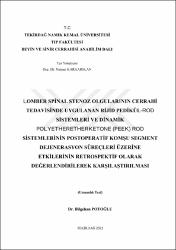| dc.contributor.advisor | Karaarslan, Numan | |
| dc.contributor.author | Potoğlu, Bilgehan | |
| dc.date.accessioned | 2022-04-06T06:49:24Z | |
| dc.date.available | 2022-04-06T06:49:24Z | |
| dc.date.issued | 2021 | |
| dc.identifier.uri | https://tez.yok.gov.tr/UlusalTezMerkezi/TezGoster?key=9MiDp3x86xrwjpi5-14w-UX569LTU4HJBIANdZV2qJgU8wdZVORBUaJUze-EVzPx | |
| dc.identifier.uri | https://hdl.handle.net/20.500.11776/4095 | |
| dc.description.abstract | Lomber spinal stenoz (LSS), özellikle 65 yaş üstü olgularda kalça ve alt ektsremitelerde ortaya çıkan ağrının ve fonksiyonel kaybın en sık nedenidir. Yaşam kalitesini önemli ölçüde etkileyen bu patolojiler ülke ekonomilerine de önemli ölçüde yük getirmektedir. Lomber spinal stenoz olgularında, cerrahi ve cerrahi dışı tedavi arasında tercih yapılması gerektiğinde, olguların klinik bulgularının tedavi seçenekleri açısından en önemli yol gösterici olduğu önerilse olsa bile cerrahi tedavi yöntemlerinin, cerrahi dışı tedavi yöntemlerine göre daha etkin modaliteler olduğu ileri sürülmüştür. Komşu segment hastalığı ise LSS nedeni ile opere edilmiş hasta grubunda en sık reoperasyon nedenidir. Bu çalışmanın amacı; komşu segment hastalığına yönelik posterior transpediküler füzyon sistemlerinin morfometrik değişimler açısından karşılaştırılmasıdır. Rijid titanyum rod ve PEEK rod uygulanmış olgular kendi içlerinde operasyon öncesi ve operasyon sonrası morfometrik veriler açısından değerlendirilmiş, bunun yanı sıra gruplar birbirleri ile de kıyaslanmıştır. Özellikle komşu segmentlerin kanal hacmini korumada, komşu segmentlerde hem anterior hem posterior disk yükseklik kayıplarını önlemede, üst komşu segmentteki foramen yüksekliklerinin korunmasında ve alt ve üst komşu segmentteki hem sağ hem sol ligamentum flavum hipertrofisini önlemede PEEK rod sistemlerinin daha etkin stabilizasyon sistemleri olduğu saptanmıştır. Dolayısı ile LSS olgularında stabilizasyon amaçlı PEEK rod sistemlerinin, gelişebilecek komşu segment hastalığı riskini azaltabileceği görülmektedir. Sonuç olarak; özellikle ileri yaş bireylerde oldukça sık karşılaşılan, ekonomik, psikososyal ve yaşam kalitesi açısından ciddi sonuçları olan LSS'de seçilecek olan cerrahi yöntemin ve stabilizasyon sisteminin, opere edilmiş LSS olgularında en sık reoperasyon nedeni olarak düşünülen komşu segment hastalığına etkileri açısından daha çok klinik çalışma yapılması büyük bir önem taşımaktadır. | en_US |
| dc.description.abstract | Lumbar spinal stenosis (LSS) is the most common cause of pain and functional loss in the hip and lower extremities, particularly in patients over 65 years of age. These pathologies significantly affect the life quality and impose a heavy economic burden on the countries. The clinical findings are the most important guide in determining the appropriate treatment options in LSS cases. However, it has been suggested in the literature that surgical treatment methods are more effective than non-surgical treatment methods. Adjacent segment disease is the most common cause of reoperation in patients operated on for the treatment of LSS. This study aims to compare posterior transpedicular fusion systems using for the surgical treatment of LSS in terms of morphometric changes. The cases in which rigid titanium rod and PEEK rod were applied were evaluated in terms of Pre- and postoperative morphometric data of rigid titanium rod and PEEK rod systems applied patients were evaluated and the group data were also compared with each other. It has been observed that PEEK rod systems provide more effective stabilization, especially in preserving the canal volume of adjacent segments, preventing loss of both anterior and posterior disc height in adjacent segments, preserving foramen heights in the upper adjacent segment, and preventing both right and left ligamentum flavum hypertrophy in the lower and upper adjacent segments. Therefore, PEEK rod systems may reduce the risk of adjacent segment disease in LSS cases. LSS is a very common disorder, especially in elderly people, with serious economic and psychosocial consequences. In conclusion, more clinical studies are needed to accurately determine the effects of the surgical method and stabilization system using for the treatment of this disease on adjacent segment disease which is the most common cause of reoperation in operated LSS cases. | en_US |
| dc.language.iso | tur | en_US |
| dc.publisher | Tekirdağ Namık Kemal Üniversitesi | en_US |
| dc.rights | info:eu-repo/semantics/openAccess | en_US |
| dc.subject | Nöroşirürji | en_US |
| dc.subject | Neurosurgery | en_US |
| dc.subject | Lomber vertebra | en_US |
| dc.subject | Lumbar vertebrae | en_US |
| dc.title | Lomber spinal stenoz olgularının cerrahi tedavisinde uygulanan rijid pedikül-rod sistemleri ve dinamik polyetheretherketone (peek) rod sistemlerinin postoperatif komşu segment dejenerasyon süreçleri üzerine etkilerinin retrospektif olarak değerlendirilerek karşılaştırılması | en_US |
| dc.title.alternative | Retrospecti?ve and comparati?ve evaluati?on of the effects of ri?gi?d pedi?cle screw-rod systems and dynami?c polyetheretherketone (PEEK) rod systems performed for the surgi?cal treatment of pati?ents wi?th lumbar spi?nal stenosi?s on postoperati?ve adjacent segment degenerati?on processes | en_US |
| dc.type | specialistThesis | en_US |
| dc.department | Enstitüler, Tıp Fakültesi, Beyin ve Sinir Cerrahisi Ana Bilim Dalı | en_US |
| dc.identifier.startpage | 1 | en_US |
| dc.identifier.endpage | 116 | en_US |
| dc.institutionauthor | Potoğlu, Bilgehan | |
| dc.relation.publicationcategory | Tez | en_US |
| dc.identifier.yoktezid | 669759 | en_US |



















